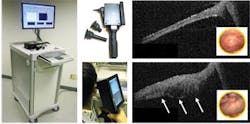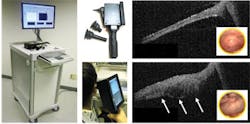OPTICAL COHERENCE TOMOGRAPHY/GENERAL MEDICINE: Low-cost OCT probe targets primary care, developing countries
A handheld scanner designed for primary care settings would improve the ability of physicians to diagnose illnesses, quantitatively monitor chronic conditions, and perhaps make more efficient and accurate referrals to specialists. It would provide more data on all the sites doctors commonly examine and more—for instance, highlighting bacterial colonies in the middle ear in 3D, or measuring the thickness and health of patients' retinas.
The scanner could replace the instruments in current use that are essentially magnifying glasses, says Stephen Boppart, professor of Electrical and Computer Engineering, Bioengineering, and Medicine at the University of Illinois at Urbana-Champaign (UIUC) and leader of the instrument's development team. The optical coherence tomography (OCT) system includes a near-infrared (NIR) light source, a microelectromechanical systems (MEMS)-based scanner to direct the light, and a video camera to relay real-time images of surface features and scan locations.
Diabetic patients in particular may benefit from the device. Nearly half of diabetics develop retinopathy (leaky blood vessels in their retinas), which can lead to thickening of the retina, blurry vision and, eventually, blindness. The probe could catch retinopathy in its early stages and even help diagnose diabetes.
The researchers hope that falling production costs combined with more compact designs will make the scanner a common point-of-care tool and a viable option for use in developing countries. Boppart and his collaborators recently received a $5 million grant to further refine the device.

